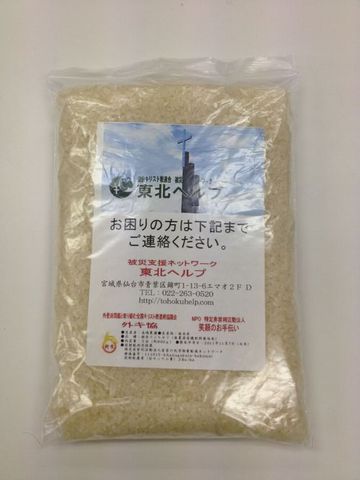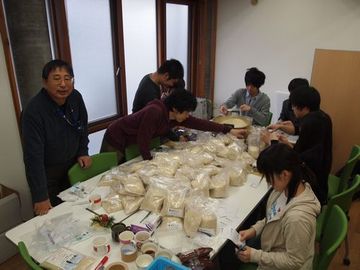Rice for Hope Project
Tohoku HELP in cooperation with other organizations has been conducting the “Non-Japanese Disaster Victims Support Project”.
There were more than 70,000 non-Japanese living in the disaster affected areas prior to the Great East Japan Earthquake. A large number of these were the so-called “Non-Japanese Wives”. To date their status and present living conditions have remained largely unreported and unknown. In cooperation with academic researchers and the help of survey volunteers, we have been conducting door-to-door surveys in a number of areas focusing on temporary housing complexes.
While many may think that conducting these surveys is quite easy involving nothing more than simply visiting temporary housing complexes and the surrounding neighborhoods in the various areas, in actuality they require a huge amount of time and energy. Firstly it is essential to build a good relationship of trust with the residents at the temporary housing complexes. This then lets us ask where any non-Japanese may be residing, which in turn enables us to meet with those non-Japanese residents to conduct the survey to discover their support needs.
The NPO “Egao” (Helping People Smile) actually conducted these door-to-door surveys.
“Egao” since long before these disasters has been focused on addressing the human rights issues confronted by “Non-Japanese Wives”. As a result of performing these surveys new lines of communication were opened up with those living in temporary housing complexes, which enabled us to obtain much valuable information.
When we visited these temporary housing complexes and stated that we were a “Christian Organization”, the overwhelming response was one of welcome and gratitude. The first thing that many people said was “Thank you so much for your help.”
It was truly a reminder of the hard times that these people have experienced since these disasters. By visiting the residents in these temporary housing complexes we have been able to gain a lot of valuable information. However at a meeting concerning this project, volunteers from “Egao” expressed the opinion that they felt uncomfortable knocking on someone’s door “empty handed” and “without at least providing a small gift”.
Taking this into consideration we reached the conclusion that volunteers should not just turn up on people’s doorsteps “without a gift”. However we also considered that receiving “something excessive” may also make the recipients feel uneasy and in addition we took into consideration the limits on our budget. (As there are thousands of temporary housing complex units.)
These considerations gave rise to the launch of the “Rice for Hope” project.
We thought about the best and most useful “small gift” that residents of temporary housing complexes could receive that wouldn’t clutter up their units. What came to mind was “Rice”. So what we decided on was to fill individual bags of rice with 5 standard Japanese measuring cups (approx. 750g) with labels concerning ongoing disaster support activities information and messages of thanks for cooperation in these activities. These bags of rice were distributed to households in the temporary housing complexes.
Our basic idea was that this small gift would further open lines of communication and also allow us to discover the hidden needs of residents in the temporary housing complexes.
To obtain the rice necessary for this project, our initial intent was to put out a call to all prefectures in Japan to donate rice to be known as the “1kg Rice Campaign”. However we came to realize that without massive preparations at the receiving point, just accepting donated rice would be extremely problematic.
So as an initial trial, we contacted the Shounai Church in Yamagata. Pastor Yazawa of that Church put out a called to the parent’s of the children who attended the church-affiliated daycare center. These parents from the Shounai Church daycare center held a charity bazaar to raise funds and as a result Mr. Daisuke Sato, the president of this daycare center parents association, was able to purchase and deliver 160kgs of Shounai rice.
At our end we affixed labels stating where this rice was grown and with our thanks packed it into individual bags.
On November 23, a public holiday, 11 volunteers being students of Tohoku Gakuin University turned out to help in packing this rice into individual bags under the supervision of the office manager Mr. Nagashima. As each bag was filled with rice, it was also filled with the prayers and best wishes of the volunteers filling it.
Up until this time Tohoku HELP’s major role had been to act as a liaison between volunteers and other organizations, and we hadn’t actually directly recruited volunteers for these types of activities.
This project provided us with our first opportunity to directly recruit volunteers and it is our hope that with the support of all our staff and God willing we will be able to implement a number of such projects in the future.
With our sincerest thanks to all those concerned with the Shounai Church, students from Tohoku Gakuin University and everyone who supports our staff from both within Japan and abroad, we are pleased to be able to provide you with this report outlining the success of the “Rice for Hope” project.
(Report by Naoya Kawakami November 26, 2011)



